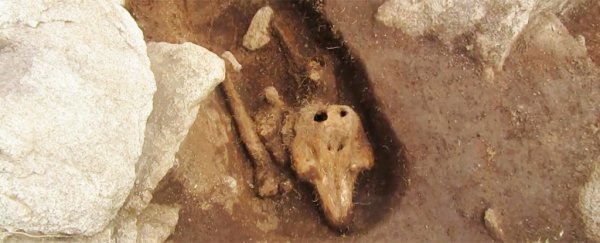A three-week archaeological dig in the English Channel took a bizarre, inexplicable turn, after researchers chanced upon a carefully cut grave hidden in the soil – the contents of which were definitely not human.
The discovery, made on the small island of Chapelle Dom Hue off the coast of Guernsey in September 2017, revealed the ancient remains of a medieval porpoise buried in the earth, and scientists are at a loss to explain the story behind this mysterious animal tomb.
"It's very peculiar, I don't know what to make of it," archaeologist Philip de Jersey from Oxford University in the UK told The Guardian.
"Why go to the trouble of burying a porpoise in what looks like a grave?"
The mystery is all the greater due to the way the animal was buried, which doesn't suggest the dead porpoise was simply disposed of underground.
Instead, it looks like it's been laid to rest, with the body aligned east to west per Christian tradition, and the careful digging of the grave itself suggests it was intended as a solemn resting place.
For that reason, de Jersey expected to find the remains of a medieval monk in the tomb, as the island is thought to have been a religious retreat for monks seeking refuge.
But after noticing changes in the soil, which indicated the likely existence of a grave underneath, the researchers uncovered the skull of a juvenile porpoise, which they think has been entombed alongside the graves of other monks since some time in the 14th century.
It's possible that the porpoise was killed for food, since these mammals were eaten in medieval times.
But if that's the case, the researchers say it would have made a lot more sense for people to have disposed of the remains in the sea – located just 10 metres from the site, and the small island is surrounded by water on all sides.
 Guernsey Archaeology/YouTube
Guernsey Archaeology/YouTube
"If we were in a church and we found something like this, based on the shape, we would think it was a grave cut," de Jersey told the Guernsey Press.
"That is what puzzles me. If they had eaten it or killed it for the blubber, why take the trouble to bury it?"
One possibility is that the animal may have been killed for food and carefully stored until it was needed, but the preserved remains were never used, de Jersey thinks.
"It may have been packed in salt and then for some reason they didn't come back to it," he told The Guardian.
After their discovery, the porpoise bones were removed from their resting place, and will now be studied by a marine expert.
Once that analysis is complete, maybe then we'll get some answers on just how and why this medieval porpoise came to be laid to rest in a monk's graveyard.
For his part, de Jersey says it's the strangest find in his 35-year career as a scientist, and a true riddle for the ages.
"The dolphin has a strong significance in Christianity but I've not come across anything like this before," he said.
"It's the slightly wacky kind of thing that you might get in the Iron Age but not in medieval times."
